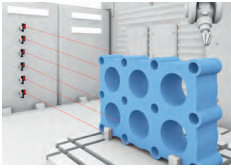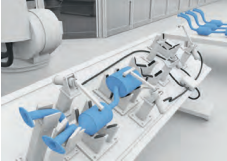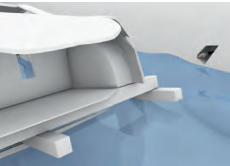Introduction
Proximity sensors are devices that detect the presence or absence of an object within a certain distance without physical contact. They are widely used in the automotive industry for various applications such as quality control, position detection, assembly line automation, paintshop, and welding. In this article, we will discuss the different types of proximity sensors, their applications in the automotive industry, advantages, challenges, and limitations.
Types of Proximity Sensors
There are four main types of proximity sensors used in the automotive production line:
-
Inductive Sensors detect metallic objects by generating an electromagnetic field. When a metallic object enters the field, it induces a current in the sensor, which triggers a signal.
-
Capacitive Sensors detect both metal and non-metallic objects by measuring changes in capacitance. When an object enters the sensor's field, it changes the capacitance, which triggers a signal.
-
Photoelectric Sensors use light to detect objects. Photoelectirc sensors emit a beam of light and detect changes in the amount of light that is reflected back. When an object enters the beam, it reflects more light back to the sensor, which triggers a signal.
-
Ultrasonic Sensors use sound waves to detect objects. They emit high-frequency sound waves that bounce off objects and return to the sensor. The time it takes for the sound waves to return is used to calculate the distance to the object.
Areas of Application in the Automotive Production Line
Powerchain
Position Detection: Proximity sensors are used to detect the position of automotive parts during machine center. They can detect the presence or absence of parts, as well as their position and orientation.
For example, photoelectric distance sensors in modern machining centers enable precise machining of workpieces. They quickly determine the correct clamping position with extreme precision, while being resistant to coolants and lubricants due to their durable glass optics and metal housing.

Assembly Line
Assembly Line Automation: Proximity sensors are used to automate the assembly line by detecting the presence or absence of parts and triggering the next step in the process. This reduces the need for manual labor and improves efficiency.
In final assembly, inductive distance sensors detect gripper jaw motion on the robot gripper system. They can be fully integrated and are ideal for fast-moving applications, monitoring lightweight robots during tasks like shock absorber installation or precise door seal application.

Welding
Proximity sensors are used to detect the position of parts during welding. They can detect the distance between parts and ensure that they are properly aligned before welding.
Balluff provides robust sensors and cables designed to withstand weld splatter, shocks, and mechanical loads during exhaust system welding. Our inductive sensors with stainless steel faces can be directly installed in demanding environments, and special cables made of silicon or PTFE are ideal for welding applications.

Paintshop
Our resistant sensors enable robots to apply five layers seamlessly using high-speed electrostatic rotary bell sprayers, immediately after the body shell is cleaned and degreased in the dipping process.
Balluff's capacitive immersion sensors detect high-conductive media used for cathodic e-coating, while filtering out foam, liquid films, and contamination. They offer reliable and accurate results and can be installed in both plastic and metal tanks, providing flexibility in their usage

Advantages of Using Proximity Sensors in Automotive Production Line
-
Improved Efficiency: Proximity sensors automate tasks, saving time.
-
Cost Savings: Reduced manual labor lowers expenses.
-
Reduced Labor Requirements: Enhances working conditions and reduces injury risk.
-
Improved Safety: Detecting objects, triggering safety measures, and protecting workers and equipment.
Challenges and Limitations of Proximity Sensors in Automotive Industry
-
Environmental Factors: Proximity sensors can be affected by environmental factors such as temperature, humidity, and electromagnetic interference. This can affect their accuracy and reliability.
-
Sensor Interference: Proximity sensors can interfere with each other if they are too close together. This can result in false readings and reduced accuracy.
-
Maintenance and Calibration: Proximity sensors require regular maintenance and calibration to ensure that they are functioning properly. This can be time-consuming and expensive.
Conclusion
Proximity sensors are an essential component of the automotive production line. They are used for quality control, position detection, assembly line automation, and welding. The advantages of using proximity sensors include improved efficiency, cost savings, reduced labor requirements, and improved safety. However, there are also challenges and limitations, such as environmental factors, sensor interference, and maintenance and calibration requirements. Overall, proximity sensors are a valuable tool for the automotive industry, and their benefits outweigh their challenges.
-
Balluff offer comprehensive technical services to ensure that your projects are properly implemented. Contact us for more details.
To become better and better together
At Balluff, we take pride in being an engaged partner for industrial automation. Our extensive range of products and services includes sensor technology, RFID and IO-Link. We work collaboratively to develop solutions that are tailored to your unique needs and can be implemented globally.
Visit more products and applications for Automotive industry and suppliers
Balluff WebShop is an all-in-one place to browse, order, and track products.
























